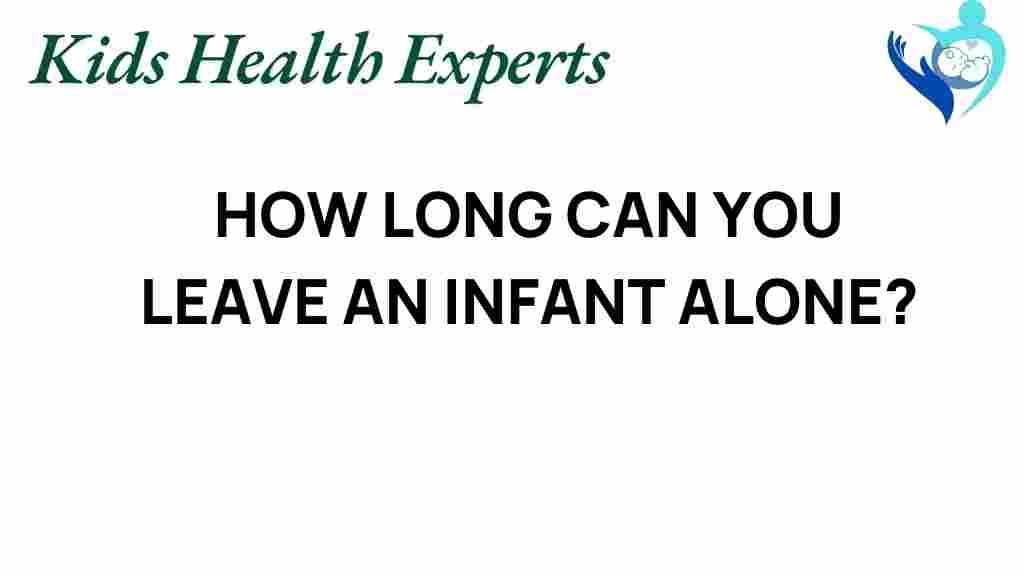Infant Care: How Long Can You Leave an Infant Alone?
As a new parent, one of the most pressing concerns is ensuring the safety and well-being of your infant. It’s natural to wonder how long you can leave your baby alone, especially as you navigate the early stages of parenting. Understanding the guidelines surrounding infant care is crucial for fostering a safe environment and supporting your baby’s development. In this article, we will delve into the surprising truth about leaving infants alone, discuss child safety measures, and provide essential parenting tips related to separation anxiety and baby monitoring.
Understanding Infant Developmental Milestones
Before addressing how long you can leave your infant alone, it’s important to understand the developmental milestones that influence your baby’s ability to be left unattended. Each child develops at their own pace, but here are some general milestones to consider:
- Birth to 3 months: Infants require constant supervision and care. They are not able to roll over or sit up and rely on caregivers for all their needs.
- 4 to 6 months: Babies begin to show some independence, such as rolling over and reaching for toys. However, they still need close monitoring.
- 7 to 12 months: As infants start crawling and pulling up, they become more mobile and curious. This increases the need for supervision.
In general, the younger the infant, the less time they should be left alone. Now, let’s discuss how long you can safely leave an infant alone based on their age and developmental stage.
Age Guidelines for Leaving an Infant Alone
Newborns (0-3 months)
Newborns are entirely dependent on their caregivers and should never be left alone. They require constant attention for feeding, diaper changes, and comfort. Leaving a newborn alone, even for a few minutes, poses significant risks.
Infants (4-6 months)
At this stage, you may briefly leave your infant alone while they are awake, but it should not exceed 10-15 minutes. Ensure you are in a safe environment, such as a crib or playpen, where they cannot roll or fall. Always keep a baby monitor nearby to listen for any distress.
Older Infants (7-12 months)
As your baby reaches 7 months and beyond, they might be able to entertain themselves for a bit longer. You can leave them alone for about 20-30 minutes while they play in a safe, supervised area. However, always ensure that you are within earshot and readily available.
Child Safety and Caregiver Guidelines
Ensuring your infant’s safety while you are briefly away is paramount. Here are some essential caregiver guidelines to follow:
- Safe Sleep Practices: Always place your infant on their back to sleep in a crib free of any soft bedding or toys.
- Secure Environment: Use gates and locks to keep your baby in a safe area. Remove any small objects that could pose choking hazards.
- Baby Monitoring: Invest in a reliable baby monitor to keep an eye (and ear) on your infant while you are in another room.
- Emergency Contacts: Have a list of emergency contacts readily available in case an urgent situation arises.
Separation Anxiety: What Parents Should Know
As your infant grows, they may experience separation anxiety, which is a normal part of development. This typically begins around 6-8 months and can peak at 10-18 months. Understanding this can help you navigate the challenges of leaving your baby alone.
Signs of Separation Anxiety
Watch for these common signs of separation anxiety:
- Clinginess when you try to leave.
- Crying or tantrums when separated.
- Difficulty calming down after separation.
Tips for Managing Separation Anxiety
Here are some parenting tips to ease the transition for both you and your infant:
- Practice Short Separations: Start with brief absences to help your baby get accustomed to being alone.
- Stay Calm: Your reactions can influence your baby’s feelings. Stay calm and reassuring during goodbyes.
- Establish a Routine: Consistency can help your infant feel secure. Create a predictable routine around separations.
Step-by-Step Process for Leaving Your Infant Alone
If you need to leave your infant alone for a short period, follow this step-by-step process to ensure their safety:
- Prepare the Environment: Ensure the area is safe and free of hazards.
- Use a Baby Monitor: Set up a baby monitor to keep an eye on your infant remotely.
- Check Your Baby: Make sure your infant is content and safe before leaving.
- Set a Timer: Limit your absence and set a timer for your return.
- Return Promptly: Make sure to return when promised to reinforce security and trust.
Troubleshooting Tips for Common Concerns
Leaving your infant alone can bring up various concerns. Here are some common issues and how to address them:
Concern: My baby cries when I leave the room.
This is a common reaction due to separation anxiety. Gradually increase the time you leave them alone, and always return when you say you will.
Concern: I’m worried about their safety.
Ensure that the space is entirely childproofed. Consider using baby gates and securing furniture to the walls to prevent tipping.
Concern: Can I leave the baby in a car seat while I’m nearby?
It’s not recommended to leave an infant in a car seat unattended, even for a moment. Always place them in a safe, flat surface.
Conclusion
Leaving an infant alone is a delicate matter that requires careful consideration of their developmental milestones, safety, and emotional needs. While it’s essential to understand how long you can leave your infant alone, always prioritize a safe environment and remain attentive to their cues. Remember, every baby is different, and trusting your instincts as a parent is key. For more parenting resources and tips, you can explore this guide on infant care. Always stay informed and prepared, and don’t hesitate to seek professional advice if you have concerns about your baby’s well-being.
This article is in the category Care and created by KidsHealthExperts Team
